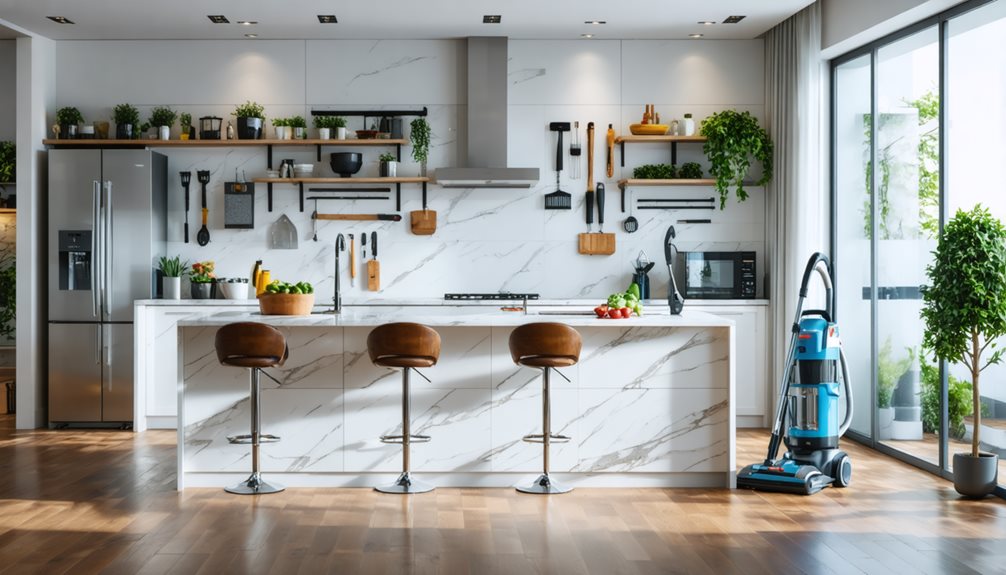Post-construction cleaning in Chantilly homes demands a systematic three-phase approach to guarantee occupant safety and thorough removal of hazardous materials. Professional-grade HEPA filtration systems capture 99.97% of airborne particles, including dangerous silica dust and VOCs. The process requires specialized equipment, proper cleaning protocols, and attention to both interior and exterior spaces. Implementing strategic cleaning methods and maintaining proper air quality management helps create a safe, healthy living environment. Understanding the complete scope of post-construction cleanup reveals essential steps for long-term home safety.
Key Takeaways
- Employ HEPA filtration systems and air purifiers throughout renovated areas to remove harmful particles and ensure safe indoor air quality.
- Schedule professional post-construction cleaning services equipped with industrial-grade HEPA vacuums for thorough dust and debris removal.
- Implement a three-phase cleaning approach: rough clean, light clean, and final clean to systematically restore your Chantilly home.
- Use specialized cleaning products and techniques for different surfaces while protecting new installations with appropriate barriers.
- Maintain proper ventilation and regular air filter maintenance to prevent respiratory risks from silica dust and VOCs.
Understanding Post-Construction Health Risks in Chantilly Homes
When homeowners in Chantilly complete renovation projects, they often overlook the invisible health hazards that linger in their newly transformed spaces. The aftermath of construction work introduces multiple respiratory risks, primarily from silica-laden construction dust and volatile organic compounds released by fresh paint and adhesives.
Post-construction cleaning becomes vital as these environments can harbor various health threats. The combination of fine particulate matter and VOCs can trigger immediate symptoms like headaches, dizziness, and respiratory irritation. In addition, construction debris may contain concealed hazards such as disturbed lead materials or asbestos fibers, requiring professional assessment. The impact on air quality extends beyond visible dust, affecting individuals with asthma and allergies particularly severely. Installing proper air filtration systems and implementing thorough cleaning protocols are essential steps in creating a safe, habitable environment after renovation work.
Essential Equipment and Supplies for Construction Cleanup
A comprehensive arsenal of cleaning equipment and supplies stands at the forefront of effective post-construction cleanup. Professional cleaning teams prioritize essential equipment like industrial-grade HEPA-filtered vacuums to capture microscopic particles and guarantee optimal air quality. Specialized cleaning products, including surface-specific solutions and sanitizers, play a vital role in achieving thorough results.
| Equipment Type | Purpose | Safety Feature |
|---|---|---|
| HEPA Vacuum | Dust/Debris Removal | 99.97% Filtration |
| Pressure Washer | Exterior Cleaning | High-power Debris Control |
| Microfiber Tools | Surface Protection | Scratch-free Cleaning |
The combination of proper equipment and appropriate cleaning products guarantees a systematic approach to post-construction cleanup. This methodical process transforms newly renovated spaces into safe, pristine environments ready for immediate occupancy, while maintaining the highest standards of cleanliness and safety.
Professional vs. DIY Construction Cleaning Methods
The decision between professional and DIY construction cleaning approaches represents a significant choice for property owners following renovation work. Professional cleaning services offer distinct advantages through specialized equipment like HEPA vacuums and air scrubbers, which far surpass typical household cleaning tools. Their systematic three-phase approach guarantees comprehensive debris removal and safety.
While DIY cleaning methods may seem cost-effective initially, they often lack the thoroughness required for post-renovation cleaning. Professional teams are specifically trained to identify and safely manage hazardous materials such as silica dust, which can pose serious health risks if improperly handled. Additionally, their expertise and specialized equipment allow for more efficient and thorough cleaning, saving homeowners valuable time and guaranteeing the space is properly prepared for occupancy.

The Three-Phase Approach to Construction Cleanup
Successful construction cleanup relies on three distinct phases, each building upon the previous to guarantee a thoroughly cleaned and habitable space.
The first phase, Rough Clean, addresses the immediate aftermath of construction by removing large debris, excess materials, and performing initial vacuuming to clear major remnants. Following this, Light Clean takes a more focused approach, targeting specific areas such as kitchens and bathrooms that require detailed attention and specialized cleaning techniques.
The Final Clean phase represents the vital finishing touch, addressing any remaining dust that may have settled and eliminating smudges from surfaces throughout the space. This systematic three-phase approach guarantees that each aspect of post-construction cleaning receives appropriate attention, resulting in a space that meets safety standards and aesthetic expectations for occupancy.
Proper Dust Removal and Air Quality Management
Professional construction cleanup demands the implementation of HEPA filtration systems, which remove 99.97% of airborne particles and create healthier indoor environments. Strategic placement of high-quality air purifiers throughout the renovation space maximizes particle capture and guarantees comprehensive air quality management. Daily dust control methods, including systematic vacuuming and surface cleaning, prevent the accumulation and spread of construction debris while maintaining safer breathing conditions during the restoration process.
HEPA Filtration Systems Matter
Maintaining pristine air quality during post-renovation cleanup demands robust HEPA filtration systems, which serve as the cornerstone of effective dust management. These advanced systems capture 99.97% of airborne particles as small as 0.3 microns, providing superior protection against construction debris and allergens.
Industrial HEPA vacuums excel at handling large volumes of dust and debris, making them essential tools for thorough post-construction cleaning. When integrated into both vacuums and air purifiers, HEPA filtration systems significantly improve indoor air quality by reducing harmful airborne particles. To guarantee peak performance and maintain clean air throughout the renovation recovery process, regular filter replacement is vital. Neglecting filter maintenance can compromise the system’s efficiency and diminish its ability to protect occupants from respiratory issues and allergic reactions.
Strategic Air Purifier Placement
While construction cleanup presents numerous challenges, strategic air purifier placement stands as a critical factor in achieving optimal dust removal and maintaining healthy indoor air quality. By positioning air purifiers near construction zones and high-traffic areas, homeowners can effectively capture dust particles before they spread throughout the space.
For best results, installing multiple high-quality air purifiers equipped with HEPA filtration technology guarantees comprehensive coverage, removing 99.97% of particles as small as 0.3 microns. Regular filter maintenance boosts their performance, particularly during post-renovation periods when dust levels are heightened. Integration with proper ventilation methods, such as exhaust fans and strategic window placement, creates a more effective system for managing indoor air quality. This multi-faceted approach significantly reduces airborne contaminants, creating a healthier living environment after renovation work.
Daily Dust Control Methods
Effective daily dust control during renovation projects requires a systematic approach combining multiple cleaning methods and preventive measures. Implementing daily dust control methods involves strategic use of HEPA-filtered vacuums, proper barrier installation, and regular filter maintenance. Professional cleaning services can assist in maintaining these standards throughout the renovation process.
| Task | Frequency | Responsibility |
|---|---|---|
| HEPA Vacuuming | Daily | Contractor/Owner |
| Air Purifier Check | Twice Daily | Owner |
| Barrier Inspection | Daily | Contractor |
| Filter Changes | As Needed | HVAC Professional |
Post-renovation cleanup success depends on consistent maintenance of these protocols. Homeowners should guarantee proper containment of construction zones using plastic barriers while maintaining air purifier placement in strategic locations. Regular monitoring of HVAC filters prevents system strain and maintains ideal air quality throughout the renovation process, contributing to a healthier living environment.
Protecting Your New Surfaces During the Cleaning Process
Once construction work is complete, protecting newly installed surfaces during the post-renovation cleanup requires careful planning and preventive measures. Properly safeguarding new finishes begins with laying down protective barriers like drop cloths and plastic sheets before initiating the cleaning process.
Professional cleaners recommend testing cleaning solutions on small, hidden areas first to verify compatibility with different surface materials. For delicate surfaces such as natural stone or polished wood, gentle cleaning methods using microfiber cloths help prevent scratches and damage during the renovation process. When using vacuum equipment, HEPA-filtered systems are essential to capture fine dust particles without risking surface abrasion.
Timing is also vital – scheduling thorough cleaning after all installations are finished minimizes the risk of damage while ensuring comprehensive protection of newly renovated spaces.
Deep Cleaning Techniques for Different Room Types
Professional cleaning of renovated kitchens requires systematic grease removal using specialized degreasers and microfiber cloths to break down accumulated residue on cabinets, appliances, and ventilation systems. Bathroom restoration focuses on deep cleaning tile surfaces with appropriate pH-balanced cleaners, followed by thorough grout scrubbing to eliminate construction dust and debris that may have settled in porous surfaces. Both areas benefit from a final sanitization step using EPA-registered disinfectants to guarantee surfaces are not only visually clean but also hygienically safe for immediate use.
Kitchen Grease Removal Steps
Tackling kitchen grease removal requires a systematic approach to guarantee thorough cleaning after renovation work. During this critical cleaning phase, professionals start by applying an effective degreaser or a vinegar-baking soda mixture to all affected surfaces, allowing proper penetration time.
For best results, cleaners use microfiber cloths to methodically scrub greasy areas, paying special attention to corners and crevices where kitchen grease typically accumulates. Stubborn stains on walls and cabinets require a specialized approach using a baking soda paste, which should remain on surfaces for 10-15 minutes before scrubbing. Kitchen appliances demand particular attention, utilizing either commercial cleaners or a vinegar-dish soap solution for thorough cleaning. The final step involves rinsing all surfaces with warm water and ensuring complete drying to prevent future grease accumulation.
Bathroom Tile Deep Clean
Restoring bathroom tiles to their original luster requires a methodical deep cleaning approach after renovation work. Professional cleaners begin by applying pH-neutral cleaners specifically formulated for tile surfaces, effectively removing construction debris and accumulated grime without compromising the tile integrity.
Steam cleaning technology provides an additional layer of sanitation, penetrating deep into tile surfaces and grout lines to eliminate bacteria and stubborn residue. For particularly resistant stains, a natural solution of baking soda and vinegar creates a powerful cleaning paste. After thorough cleaning, professionals apply grout sealer to protect against future moisture damage and staining. This comprehensive approach, recommended every 3-6 months for maintenance, guarantees the bathroom tiles maintain their appearance and structural integrity long after the renovation is complete.
Exterior Construction Site Cleanup Priorities
Once construction work concludes, the exterior cleanup phase becomes a critical step in completing the renovation process. The cleaning team must first address safety concerns by removing debris and construction materials from walkways, driveways, and surrounding areas to guarantee unobstructed access to the property.
After establishing safe pathways, attention shifts to cleaning exterior surfaces. Pressure washers prove instrumental in efficiently removing construction dust, dirt, and grime from walls, decks, patios, and fencing. Windows require special attention, with thorough cleaning of both glass panes and frames using appropriate cleaning solutions. The final phase involves a comprehensive inspection of the property’s exterior to identify and remove any remaining hazards, such as exposed wires or sharp objects, guaranteeing the renovation site transitions into a safe, habitable environment.
Time-Saving Strategies for Efficient Post-Construction Cleaning
As renovation teams complete exterior cleanup, attention naturally shifts to optimizing the interior cleaning process. Implementing a structured three-phase approach—rough, light, and final clean—enables systematic removal of construction debris and dust. Expert cleaning professionals recommend utilizing industrial-grade equipment, including wet dry vacuums and HEPA air purifiers, to efficiently capture fine particles.
Many homeowners find that partnering with a post construction cleaning company maximizes efficiency through specialized expertise and equipment. For those managing the cleanup independently, distributing specific tasks among family members guarantees comprehensive coverage. Time-saving tools like microfiber cloths and all-purpose cleaners significantly reduce cleaning duration. Additionally, maintaining daily cleaning routines throughout the renovation process minimizes final cleanup efforts. This proactive approach prevents excessive dust accumulation and creates a more manageable post-construction cleaning experience.
Environmental Considerations in Post-Construction Cleanup
Professional post-construction cleaning requires careful selection of eco-friendly cleaning products that effectively remove debris while protecting both occupants and the environment from harmful chemical exposure. The implementation of HEPA filtration systems during cleanup operations captures 99.97% of airborne particulates, establishing a vital foundation for healthy indoor air quality. These advanced filtration practices, combined with green cleaning solutions, create a comprehensive approach that addresses both immediate cleaning needs and long-term environmental impact.
Green Cleaning Products Matter
Environmental responsibility extends beyond the construction phase into post-renovation cleanup, where the choice of cleaning products significantly impacts both indoor air quality and ecological sustainability. Green cleaning products, certified by programs like EPA’s Safer Choice, offer a safer alternative to conventional cleaners during post-construction cleanup.
These environmentally conscious solutions effectively remove construction debris and allergens while eliminating the release of harmful volatile organic compounds (VOCs) that can compromise indoor air quality. The biodegradable formulations guarantee minimal impact on local water systems and aquatic life when disposed of through drainage systems. Additionally, incorporating green cleaning products supports sustainability initiatives and can contribute to achieving eco-friendly building certifications like LEED. This approach demonstrates a commitment to both environmental stewardship and occupant health throughout the entire renovation process.
HEPA Filtration Best Practices
While green cleaning products establish a foundation for eco-conscious cleanup, proper HEPA filtration systems serve as the cornerstone of maintaining superior air quality during post-construction cleaning. These advanced filters effectively capture 99.97% of particles as small as 0.3 microns, providing essential protection against construction dust and harmful airborne contaminants.
To maximize HEPA filtration effectiveness, several key practices must be implemented. Air purifiers equipped with HEPA filters should be strategically placed throughout the renovation area, while HEPA vacuum cleaners should be operated at a deliberate pace to guarantee thorough particle capture. Regular maintenance, including filter replacement every 3-6 months, is vital for peak performance. This systematic approach to HEPA filtration not only safeguards occupant health but also contributes to environmental sustainability by preventing the spread of harmful construction debris.
Frequently Asked Questions
How Do You Deep Clean a House After Renovation?
Deep cleaning after renovation requires a systematic approach to effectively remove construction dust and debris. One should start by clearing all debris and using a HEPA vacuum on all surfaces, including carpets and upholstery. Next, dusting with microfiber cloths prevents dust redistribution. Following this, surfaces should be wiped with damp cloths and cleaning solutions. Finally, replacing HVAC filters is essential for maintaining improved air quality post-renovation.
Who Is Responsible for Cleanup After Construction?
Cleanup responsibilities after construction are typically shared between contractors and property owners. Contractors are generally responsible for removing large debris, construction materials, and leaving the space in a broom-swept condition. Property owners are responsible for detailed cleaning and fine dust removal. It’s crucial to clearly define cleanup responsibilities in the construction contract to avoid misunderstandings and guarantee all areas are properly addressed for safety and health reasons.
What Are the Three Phases of Post-Construction Cleaning?
Like peeling back layers of an onion, post-construction cleaning progresses through three distinct phases. The Rough Clean phase begins by removing large debris, construction materials, and performing initial vacuuming. The Light Clean phase focuses on intensive cleaning of specific areas like restrooms and kitchens. Finally, the Final Clean phase addresses settled dust, smudges, and detail work, ensuring the space meets occupancy standards for safety and cleanliness.
How Do I Clean the Air in My House After Renovating It?
To clean indoor air after renovations, homeowners should deploy HEPA air purifiers strategically throughout the space, as these devices effectively capture 99.97% of airborne particles. It’s essential to replace HVAC filters and seal off vents during cleanup. Using industrial wet/dry vacuums with HEPA filtration helps remove construction dust, while maintaining proper ventilation by opening windows can help exchange stale air with fresh outdoor air.





